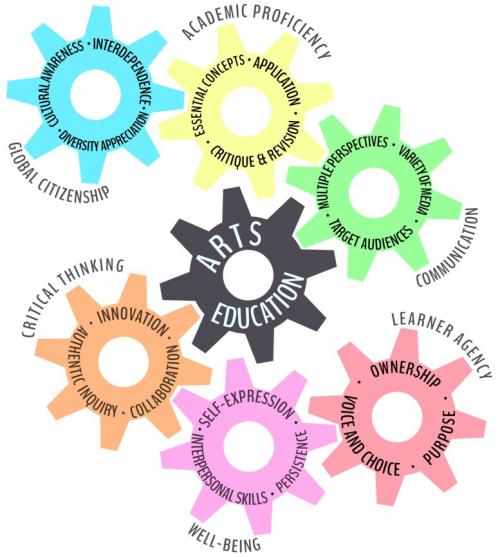What Qualifies as a Performance Art in Middle School Education?

The visual and performing arts provide avenues for students to investigate and develop a positive sense of self, place, and purpose. Approved for adoption by the Vermont State Board of Didactics in 2016, the National Core Arts Standards (NCAS) address essential questions and skills to back up students in this investigation through five arts disciplines: Dance, Music, Theater, Visual Arts, and Media Arts. NCAS outline critical components of the artistic process nether the umbrella of four domains (Create, Perform/Present/Product, Respond, and Connect) to guide students through rigorous exploration of skills in creative literacy. These standards (and arts education in general) emphasize transferable skills through growth-oriented and participant-driven creative outlets to ready students for college, career, and life.
Spotlights on Equity Resources
Educational equity means that every student has admission to the resources, opportunities, and educational rigor they demand at the right moment in their education, whatever their race, gender/identity, sexual orientation, ethnicity, religion, language, ability, family background, or family income may be. (Adapted from CCSSO, Leading for Equity.) The Spotlight on Equity Resource below provides a list of considerations and resource for the purpose of supporting equity and access while emphasizing loftier-quality and culturally sustaining learning opportunities for all students.
- Performing Arts: Spotlight on Equity Resources
- Visual Arts: Spotlight on Equity Resources
Section List
Arts Education: A Path to a Portrait of a Graduate
Vermont Arts Instructional Recommendations
Newsletters
Resources
Arts Pedagogy: A Path to a Portrait of a Graduate
The visual and performing arts tin can serve as a pedagogical tool for supporting the performance indicators in the Vermont Portrait of a Graduate. Embedded in the Portrait are primal concepts explorable through the arts. Whether districts accept developed their own Portraits or are using the Vermont Portrait equally a framework, arts teaching can exist a source of guidance for intentionally and meaningfully focusing on the attributes in school settings. Information on how NCAS-aligned arts curricula can guide a Portrait of a Graduate can exist found here:
- Arts Education: A Path to a Portrait of a Graduate

The arts back up global citizenship by fostering interdependence, diversity appreciation, and cultural awareness. They back up academic proficiency by teaching skills on essential concepts, application, and revision. They support advice past focusing on students' perspectives, non-verbal strategies, and a variety of media. The arts support critical thinking through collaboration, authentic inquiry, and innovation. They support well-being through self-expression, persistence, and interpersonal skills. Lastly, they back up learner agency past offering voice and pick, ownership, and high expectations.
Return to Department Listing
Vermont Arts Instructional Recommendations
Arts programs support students in developing and sustaining skills in creative literacy while demonstrating proficiency in the National Core Arts Standards. Considerations and recommendations for providing these opportunities are described in the Visual and Performing Arts Instructional Recommendations and Resource Compendium document. The purpose of this document is to support Vermont programs in providing a holistic learning experience to students while upholding the Education Quality Standards as they pertain to the arts. In add-on to embedding attributes of a Vermont Portrait of a Graduate into arts curricula, these considerations can serve to back up preservation of the arts in schools and the essential skills and qualities obtained from arts educational activity:
- Visual and Performing Arts Instructional Recommendations and Resource Compendium
Return to Section List
Newsletters
- January 2022
- September 2021
- Apr 2021
- February 2021
- November 2020
Return to Section Listing
Resources
Learning Target Banking company
The Vermont Arts Learning Target Bank is a drove of learning targets aligned to the National Cadre Arts Standards. The targets are bachelor for all five NCAS arts disciplines: Dance, Music, Media Arts, Theater, and Visual Art. The NCAS operation standards for Kindergarten to Advanced High School have been "unpacked" into learning targets. Educators tin can utilize them to communicate targets with students or apply them to measurable criteria in a specific domain or medium.
The learning targets were created and vetted past Vermont educators to help implement the National Core Arts Standards. They are available to all Vermont educators as they go on to implement personalized, proficiency-based classroom systems.
- Introduction to the Vermont Arts Learning Target Banking company
- How to Utilise the Vermont Arts Learning Target Bank
Trip the light fantastic toe
- High School Proficient Learning Targets
Media Arts
- Loftier School Proficient Learning Targets
Music
- Kindergarten Learning Targets
- 2nd Grade Learning Targets
- 5th Form Learning Targets
- eighth Class Learning Targets
- Loftier School Proficient Learning Targets
Theater
- High School Proficient Learning Targets
Visual Art
- Kindergarten Learning Targets
- 1st Grade Learning Targets
- 2d Grade Learning Targets
- 3rd Grade Learning Targets
- quaternary Grade Learning Targets
- fifth Grade Learning Targets
- 6th Grade Learning Targets
- seventh Form Learning Targets
- 8th Grade Learning Targets
- High School Expert Learning Targets
- High School Accomplished Learning Targets
Title IV, Office A and the Arts Resources
- ESSA and the Arts Introduction
- Level of Evidence and the Arts
- ESSA and the Arts: Championship 4, Part A and FAQ
-
Impact and Outcomes of Title 4-A: Advancing children's success through access to a well-rounded education
The NAMM Foundation, together with the National Association for Music Education (NAfME), collected evidence in early 2019 well-nigh school commune employ of Title 4-A funds, or the Student Support and Bookish Enrichment Grants (SSAEG) in ESSA.
Return to Department List
Questions?
E-mail Kyle Anderson.
Source: https://education.vermont.gov/student-learning/content-areas/visual-and-performing-arts
0 Response to "What Qualifies as a Performance Art in Middle School Education?"
Post a Comment